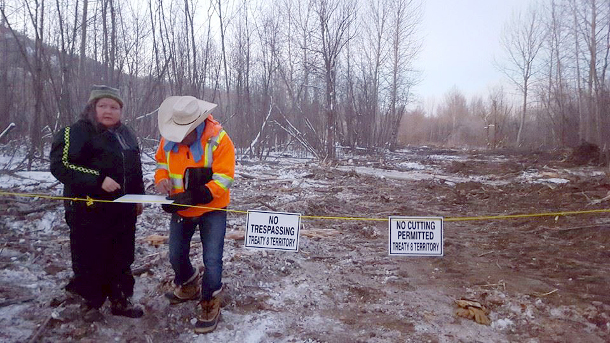One of the archaeologists who excavated the first European fur trading post in B.C. says much remains to be discovered about historical First Nations encampments near the site and valuable information will be lost forever if it is flooded for the Site C dam.
Lakehead University professor Scott Hamilton, a specialist in fur trade historic archaeology and ethnohistory, was a PhD student at Simon Fraser University when he spent two summers in the 1980s as the "pit boss" overseeing a dig to uncover the remains of the Rocky Mountain Fort.
The site, near the confluence of the Peace and Moberly Rivers in northeastern B.C., is the scene of a First Nations-led standoff aimed at preventing BC Hydro from logging an area slated to be flooded by Site C's reservoir, which would stretch for 107-kilometres along the Peace River and its tributaries.
Treaty 8 members and local farmers are camped out in minus-20-degree weather, vowing to risk arrest to protect Rocky Mountain Fort and the rest of the Peace River Valley from Site C. They have prevented planned logging from taking place so far this year.
Hamilton said excavations in the 1980s were "very much predisposed" to focus on fort structures and not on the relationship of aboriginal communities to the forts and fur trade. He said key information about the role of First Nations could be interpreted by examining the remains of encampments used by the Beaver and Sekani peoples who came to Rocky Mountain Fort to trade furs such as beaver, marten, lynx and fisher.
Adequate time was not taken to locate and study aboriginal encampments that "slipped through the cracks" because archeologists, with funding from the now defunct B.C. Heritage Trust, were busy excavating the remains of two fort buildings they found, said Hamilton.
"What about all those hard to find, hard to interpret, widely scattered aboriginal camps that represented the aboriginal side of the ledger in the fur trade?" he said.
"This is the great unknown in so much of fur trade history. How did aboriginal people engage in this enterprise? As active participants or passive pawns? And how does this experience resonate in aboriginal communities today?"
Locating and studying First Nations encampments near Rocky Mountain Fort would offer new insights into aboriginal involvement in the fur trade, said Hamilton. "We haven't done very much of that yet and they will be gone forever if this project proceeds."
'A significant piece of western Canadian history'
The fort site, which Hamilton calls "a big deal" for its time in Canadian history, was selected in 1793 by explorer Alexander Mackenzie, who called it "an excellent situation for a fort or factory, as there is plenty of wood, and every reason to believe that the country abounds in beaver."
The fort housed French Canadian voyageurs working for the North West Company, which later merged with the Hudson's Bay Company. The outpost, where explorers David Thompson and John Finlay also stayed, was the gateway for exploration of the interior of B.C. and fur trade expansion.
Notably, Rocky Mountain Fort functioned as a provisioning centre for the fur trade industry. Using aboriginal food preservation techniques, it manufactured pemmican, or dried meat, for the long canoe journeys east to transport furs collected by aboriginal hunters to European markets. Explorers and voyageurs rendered grease from animal carcasses in order to preserve meat.
Among the many artifacts uncovered at the Rocky Mountain Fort during three-month long excavations in 1986 and 1987 were elk, bison and other animal bones, as well as grease from rendering.
David Burley, the Simon Fraser University archaeologist who oversaw the excavation project, said he is satisfied that archaeologists uncovered all the information they needed in order to understand the fort's layout and functions. "It's a significant piece of western Canadian history," said Burley.
More than 20,000 artifacts were found, from glass beads, brass cufflinks and a glass bottle originally containing "Essence of Peppermint" to fishhooks, razors, axes and awls. Traditional Native bone and antler tools, as well as Micmac-style stone pipes, were also found and boxed.
Archeologists discovered the remains of a stone fireplace made of river cobblestones in the fort's main building. "We took it apart and labeled each stone, and drew a diagram of how to put it back together again," said Burley. The fireplace is currently in boxes at SFU.
The environmental impact statement for Site C describes Rocky Mountain Fort as one of 42 heritage sites that would be affected by the dam. It says Rocky Mountain Fort was revisited as part of the study and "general site observations were made, but no assessment work was conducted as part of this program as extensive excavations have been previously completed at this site."
Hamilton said he has very mixed feelings about the idea of much of the Peace River Valley being destroyed for the $8.8 billion Site C dam. "I'm not happy with the idea of that valley being flooded because of my own personal associations, but also because of the heritage and archaeological values that are going to be compromised." ![]()
Read more: Indigenous, Environment
















Tyee Commenting Guidelines
Comments that violate guidelines risk being deleted, and violations may result in a temporary or permanent user ban. Maintain the spirit of good conversation to stay in the discussion.
*Please note The Tyee is not a forum for spreading misinformation about COVID-19, denying its existence or minimizing its risk to public health.
Do:
Do not: